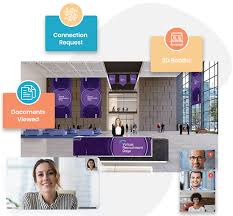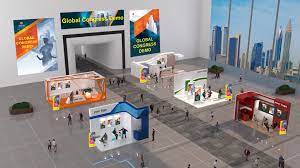Virtual Tradeshow Platform: The Future of Exhibitions
The world has changed dramatically in the last year, and the way we do business has changed along with it. With social distancing measures in place, traditional trade shows and exhibitions have become difficult if not impossible to hold. However, thanks to advances in technology, virtual tradeshows have emerged as a viable alternative.
A virtual tradeshow platform is essentially a digital environment that simulates a physical tradeshow or exhibition. Attendees can access the platform from anywhere in the world using their computer or mobile device, and they can interact with exhibitors and other attendees just as they would at an in-person event.
One of the biggest advantages of a virtual tradeshow platform is that it eliminates many of the logistical challenges associated with traditional tradeshows. There’s no need to travel to a specific location, book hotels or arrange for transportation. Instead, attendees can participate from the comfort of their own homes or offices.
Exhibitors also benefit from virtual tradeshows because they can save on costs associated with booth rental, shipping, and travel expenses. They can showcase their products and services to a global audience without having to worry about logistics.
Another advantage is that virtual tradeshows are accessible to people with disabilities who may not be able to attend traditional events due to mobility issues or other limitations. This means that exhibitors can reach a wider audience and create more inclusive experiences for everyone.
Virtual tradeshows also offer unique opportunities for engagement and interactivity. Attendees can participate in live chats, webinars, product demonstrations, and other interactive activities that allow them to engage with exhibitors and learn more about their products or services.
In addition, virtual tradeshows provide valuable data insights for both exhibitors and event organizers. They can track attendee behavior such as which booths were visited most frequently and which products generated the most interest. This data can be used to improve future events and marketing strategies.
Of course, there are some challenges to virtual tradeshows as well. Some attendees may miss the face-to-face interactions and networking opportunities that come with traditional events. Exhibitors may also find it difficult to stand out in a crowded digital environment.
However, with the right planning and execution, virtual tradeshows can be a successful alternative to traditional events. They offer many advantages over in-person events while still providing valuable opportunities for engagement and networking.
As the world continues to adapt to new ways of doing business, it’s clear that virtual tradeshows will play an increasingly important role in the future of exhibitions. By embracing this technology, businesses can reach a wider audience, save on costs, and create more inclusive experiences for everyone involved.
6 Key Benefits of Virtual Tradeshow Platforms: Cost Savings, Reach, Accessibility, Engagement, Content Sharing & Networking, and Data Collection & Insights
- Cost Savings
- Reach
- Accessibility
- Engagement
- Content Sharing & Networking
- Data Collection & Insights
Challenges of Virtual Tradeshow Platforms: Limited Interaction, Technical Issues, and High Costs
- Limited Interaction
- Technical Issues
- High Cost
Cost Savings
Virtual Tradeshow Platforms: A Cost-Effective Alternative to In-Person Events
One of the biggest advantages of virtual tradeshow platforms is their cost-effectiveness. Traditional in-person events can be expensive, with costs associated with travel, lodging, and other expenses adding up quickly. However, with virtual tradeshows, these costs are eliminated.
Attendees can participate in a virtual tradeshow from anywhere in the world using their computer or mobile device, eliminating the need for travel and lodging expenses. This makes it much more accessible to a wider audience who may not have been able to attend an in-person event due to financial constraints or logistical challenges.
Exhibitors also benefit from the cost savings of virtual tradeshows. They don’t have to worry about booth rental fees, shipping costs, or other expenses associated with traditional events. Instead, they can focus on creating engaging digital experiences that showcase their products and services to a global audience.
In addition to cost savings for attendees and exhibitors, virtual tradeshows also provide valuable data insights that can help companies improve their marketing strategies and future events. By tracking attendee behavior such as which booths were visited most frequently and which products generated the most interest, companies can tailor their marketing efforts and improve engagement at future events.
Overall, virtual tradeshow platforms offer a cost-effective alternative to traditional in-person events without sacrificing engagement or interactivity. As businesses continue to adapt to new ways of doing business in a post-pandemic world, it’s clear that virtual tradeshows will play an increasingly important role in the future of exhibitions.
Reach
Virtual Tradeshow Platforms: The Power of Reach
One of the biggest advantages of virtual tradeshow platforms is their ability to reach a wider audience than traditional physical events. While physical events are often limited by geography, virtual events can be accessed from anywhere in the world, allowing businesses to connect with potential customers from all corners of the globe.
This increased reach can have a significant impact on a business’s bottom line. By participating in a virtual tradeshow, businesses can tap into new markets and reach customers they may not have been able to connect with otherwise. This can lead to increased sales and revenue, as well as greater brand awareness and exposure.
Virtual tradeshow platforms also allow businesses to showcase their products and services in ways that may not be possible at physical events. With features such as live demos, interactive displays, and multimedia presentations, businesses can create engaging experiences that capture the attention of attendees and leave a lasting impression.
In addition, virtual tradeshow platforms provide valuable data insights that can help businesses improve their marketing strategies and better understand their target audience. By tracking attendee behavior such as which booths were visited most frequently and which products generated the most interest, businesses can make more informed decisions about how to allocate resources and where to focus their efforts.
Overall, the power of reach offered by virtual tradeshow platforms cannot be overstated. By connecting with potential customers from around the world and providing engaging experiences that leave a lasting impression, businesses can increase sales and revenue while building stronger relationships with their target audience. As more businesses embrace this technology, it’s clear that virtual tradeshows will continue to play an increasingly important role in the future of exhibitions.
Accessibility
Virtual Tradeshow Platform: The Pro of Accessibility
One of the biggest advantages of virtual tradeshows is their accessibility. With a virtual tradeshow platform, attendees can access the event from anywhere in the world with an internet connection. This makes it easier for people to participate regardless of their location or time zone.
In traditional trade shows, attendees and exhibitors must travel to a specific location and be physically present at the event. This can be a challenge for those who live far away or cannot travel due to health or other reasons. However, with virtual tradeshows, all you need is an internet connection and a device such as a computer or mobile phone.
This accessibility also means that virtual tradeshows can reach a wider audience than traditional events. Attendees from all over the world can participate in the event without having to worry about travel expenses or logistics. This means that exhibitors can showcase their products and services to a global audience, which can lead to more business opportunities.
In addition, virtual tradeshows are accessible to people with disabilities who may not be able to attend traditional events due to mobility issues or other limitations. This means that exhibitors can create more inclusive experiences for everyone involved.
Overall, accessibility is one of the key benefits of virtual tradeshows. By eliminating many of the logistical challenges associated with traditional events, virtual tradeshows make it easier for people to participate regardless of their location or situation. This creates more opportunities for engagement and networking while also providing valuable insights and data for both attendees and exhibitors alike.
Engagement
Engagement: The Key Advantage of Virtual Tradeshow Platforms
One of the biggest advantages of virtual tradeshow platforms is the increased engagement they offer between exhibitors and attendees. Through interactive features such as chats and Q&A sessions, virtual trade shows provide opportunities for engagement that may not be possible at an in-person event.
At a traditional tradeshow, attendees may feel overwhelmed by the noise and crowds, making it difficult to engage with exhibitors or ask questions. However, with a virtual tradeshow platform, attendees can easily connect with exhibitors through live chats and Q&A sessions. This allows for more personalized interactions and a greater depth of engagement.
Exhibitors can also benefit from increased engagement through virtual tradeshows. They can showcase their products or services in a more interactive way through live demonstrations or webinars. Attendees can ask questions in real-time, leading to more meaningful conversations and opportunities for lead generation.
Another advantage of virtual tradeshow platforms is that they offer greater flexibility for attendees. They can participate in events from anywhere in the world, at any time of day. This means that exhibitors have access to a wider audience than they would at an in-person event.
In addition to live interactions, virtual tradeshow platforms also offer opportunities for pre-recorded content such as product videos or educational sessions. This allows attendees to access information at their own pace and on their own schedule.
Overall, engagement is one of the key advantages of virtual tradeshow platforms. By providing interactive features such as chats and Q&A sessions, these platforms allow for more personalized interactions between exhibitors and attendees. They provide greater flexibility for both parties while still offering valuable opportunities for lead generation and networking. As businesses continue to adapt to new ways of doing business, it’s clear that virtual tradeshows will play an increasingly important role in the future of exhibitions.
Content Sharing & Networking
Virtual Tradeshow Platform: The Benefits of Content Sharing and Networking
One of the biggest advantages of virtual tradeshows is the ease with which attendees can share content and connect with other professionals in their industry. With features like video conferencing and private messaging systems, virtual tradeshows provide a platform for networking that is both convenient and effective.
Content sharing is a key benefit of virtual tradeshows. Attendees can easily access digital resources like product brochures, whitepapers, and case studies from anywhere in the world. They can also watch live presentations or on-demand webinars to learn more about specific products or services.
In addition to content sharing, virtual tradeshows offer unique opportunities for networking. Attendees can connect with exhibitors and other professionals through video conferencing, private messaging systems, or even social media channels. This allows them to build relationships and make valuable connections that can help them advance their careers or businesses.
Moreover, virtual tradeshows provide a level playing field for all attendees. In traditional events, networking opportunities may be limited to those who are physically present at the event or who have access to certain areas or events. However, in a virtual tradeshow platform, everyone has equal access to networking opportunities regardless of their location.
Another benefit of networking at virtual tradeshows is the ability to connect with professionals from all over the world. Attendees can interact with people from different countries and cultures, expanding their knowledge and understanding of global markets.
Finally, virtual tradeshows provide an opportunity for attendees to showcase their own expertise by participating in live chats or webinars. They can share their knowledge with others in their industry and establish themselves as thought leaders.
In conclusion, content sharing and networking are two key benefits of virtual tradeshow platforms that make them an attractive alternative to traditional events. By providing easy ways to share content and connect with other professionals in your industry through video conferencing and private messaging systems, virtual tradeshows offer a convenient and effective way to build relationships, expand your knowledge, and advance your career or business.
Data Collection & Insights
Data Collection & Insights: The Key Benefit of Virtual Tradeshow Platforms
One of the key benefits of a virtual tradeshow platform is the ability to collect valuable data and insights about attendees. This data can help businesses gain a better understanding of their target audience’s interests and preferences, allowing them to tailor their products or services accordingly.
With traditional tradeshows, collecting data can be difficult and time-consuming. Exhibitors may rely on surveys or sign-up sheets to gather information about attendees, but these methods are often incomplete and unreliable. In contrast, virtual tradeshows provide a wealth of data that is easy to collect and analyze.
Virtual tradeshow platforms allow exhibitors to track attendee behavior in real-time. They can see which booths were visited most frequently, which products generated the most interest, and which presentations were most popular. This data provides valuable insights into what attendees are looking for and what they find most engaging.
In addition, virtual tradeshows allow exhibitors to collect contact information from attendees who express interest in their products or services. This information can be used for follow-up marketing efforts after the event has ended.
Overall, the data collected from a virtual tradeshow platform can help businesses make informed decisions about how to best engage with their target audience. By tailoring their products or services based on attendee preferences, businesses can increase their chances of success in today’s competitive marketplace.
In conclusion, if you’re looking for an effective way to gather valuable insights about your target audience, a virtual tradeshow platform may be just what you need. With its powerful data collection capabilities and ease-of-use, it’s no wonder that more and more businesses are turning to this innovative technology as a way to stay ahead of the curve.
Limited Interaction
Limited Interaction: The Drawback of Virtual Tradeshows
While virtual tradeshows have emerged as a viable alternative to traditional events, they do come with some drawbacks. One of the main challenges is limited interaction and networking opportunities.
In-person events provide valuable opportunities for attendees to meet and network with others in their industry. They can exchange business cards, have face-to-face conversations, and build relationships that can lead to future collaborations or partnerships.
Virtual tradeshows, on the other hand, lack this in-person interaction. While attendees can participate in live chats and webinars, it’s not quite the same as meeting someone in person. It can be more difficult to build meaningful connections when you’re communicating through a screen.
Exhibitors may also find it challenging to stand out in a crowded digital environment. With so many booths and products competing for attention, it can be difficult to capture the interest of attendees and make a lasting impression.
However, there are ways to mitigate these challenges. Some virtual tradeshows offer features like one-on-one video chats or matchmaking services that connect attendees with exhibitors based on their interests or needs. These tools can help facilitate more meaningful interactions and networking opportunities.
Overall, while limited interaction is a drawback of virtual tradeshows, it’s not necessarily a deal-breaker. With the right planning and execution, businesses can still benefit from participating in these events by reaching a wider audience and showcasing their products or services in an innovative way.
Technical Issues
Technical Issues: A Challenge of Virtual Tradeshows
While virtual tradeshows offer many advantages over traditional events, they also come with their own set of challenges. One of the most significant challenges is technical issues.
Virtual tradeshows rely heavily on technology, including video conferencing, streaming audio and video, and other technical components. These components can be susceptible to technical issues or glitches during the event, which can negatively impact the attendee experience.
For example, poor internet connection or bandwidth issues can cause streaming delays or interruptions in audio and video feeds. This can make it difficult for attendees to engage with exhibitors or participate in live activities. Technical issues can also lead to frustration and a negative perception of the event.
To mitigate these challenges, event organizers must prioritize technical planning and preparation. This includes conducting thorough testing of all technical components before the event and having backup plans in place in case of any issues that arise during the event.
Exhibitors should also be prepared to troubleshoot any technical issues that may arise on their end. This may involve having a dedicated IT team available during the event to address any problems that attendees may encounter while visiting their booth.
While technical issues are a challenge for virtual tradeshows, they are not insurmountable. With proper planning and preparation, organizers can ensure a smooth and successful virtual event for all involved.
High Cost
One of the cons of virtual tradeshow platforms is the high cost associated with setting them up and managing them. While virtual tradeshows offer many advantages over traditional events, they require a significant investment in technology to make them work effectively.
Setting up a virtual tradeshow platform requires various technologies such as video conferencing software, web development tools, and hosting services. These technologies can be expensive to acquire, and they also require specialized expertise to set up and manage.
In addition, managing a virtual tradeshow platform requires ongoing maintenance and support. This includes ensuring that the platform is secure and reliable, providing technical support to attendees and exhibitors, and monitoring the platform for any issues that may arise.
All of these costs can add up quickly, making it difficult for smaller businesses or organizations with limited budgets to participate in virtual tradeshows. However, it’s important to note that the cost of setting up a virtual tradeshow platform can be offset by the savings in travel expenses and other costs associated with traditional events.
Despite the high cost of setting up a virtual tradeshow platform, many businesses are still choosing to invest in this technology as a way to reach new audiences and expand their reach. As more companies embrace this technology, we can expect to see continued innovation in this space that will make virtual tradeshows even more accessible and cost-effective for everyone involved.




